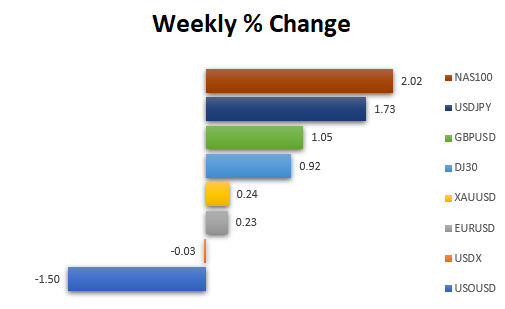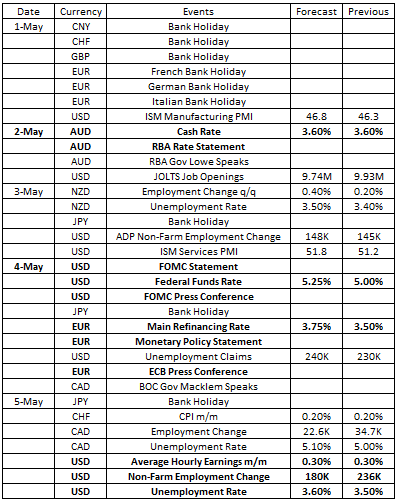فصل 5 Market Focus 1st May 2023
Week Ahead: Will the Fed Funds Rate and US Non-Farm Payroll Data Move the US Dollar?
What happened in the market last week?
• Economic indicators presented a mixed picture of the global economy. Australia and the United States are witnessing slowdowns in growth and inflation, while Japan is experiencing an uptick in consumer demand. Market participants and policymakers alike will be closely monitoring these trends as they navigate the challenges and opportunities that lie ahead.
• Australia's q/q CPI fell from 1.9% to 1.4% in Q1, indicating a slower pace of inflation, while the yearly CPI decreased from 6.8% to 6.3%, offering some relief to consumers and policymakers grappling with elevated inflation's impacts on the economy.
• In the United States, Q1 GDP growth fell from 2.6% to 1.1%, which could be due to the Federal Reserve hiking interest rates. It remains to be seen if this trend will continue, but the Fed is likely to consider this data favourable.
• Japan's economy has shown signs of expansion, with Tokyo Core CPI rising from 3.2% to 3.5% on a yearly basis, indicating an increase in consumer demand that could boost economic growth. The Bank of Japan has kept interest rates unchanged at -0.1%, reflecting its commitment to supporting the economy's recovery from the pandemic's impact.
Last Week Market Pair Changes
The US dollar remained stable, with a slight decrease of 0.03% in the USDX. The stability came after the release of data showing inflation growth in March, although at a slower rate, which further solidified the Fed’s plan to raise interest rates at the upcoming monetary policy meeting.
• USOUSD decreased by 1.50% due to worries about a recession caused by increased interest rates in major developed economies.
• EURUSD and GBPUSD increased by 0.23% and 1.05% respectively.
• XAUUSD increased by 0.24%.
• US stocks were lifted by positive earnings reports from tech companies, resulting in a 0.92% increase in the DJ30 and a 2.02% increase in the NAS100,
• USDJPY increased by 1.73% after BOJ created a negative reaction from the market.
What to focus on this week?
This week, market participants await the release of highly awaited economic reports, which will highlight key indicators such as Rate Statements in the US and Australia, as well as Employment Change in the US and Canada. These reports have immense significance as they enable traders and investors to make informed decisions and stay ahead of the market.
1 May 2023 | US ISM Manufacturing PMI
The US ISM Manufacturing PMI fell to 46.3 in March 2023, the lowest since May 2020.
Analysts expect a reading of 46.6 for April 2023.
2 May 2023 | Reserve Bank of Australia Rate Statement
During its April meeting, the RBA held its cash rate steady at 3.6%, in line with market expectations. This marks the first pause in the current hiking cycle, which began in May 2022.
For April, analysts expect the central bank to keep the rate unchanged at 3.6%.
3 May 2023 | US ISM Services PMI
The US ISM Services PMI dropped to 51.2 in March 2023 from 55.1 in February 2023, the slowest growth in three months.
For April, analysts expect a reading of 50.6.
3 May 2023 | FOMC Meeting and Funds Rate
The Fed raised its funds rate by 25bps to 5% in March 2023.
Despite a slower inflation rate, analysts anticipate that the central bank will continue to raise interest rates, with another 25bps hike to 5.25% in April 2023.
4 May 2023 | European Central Bank Main Refinancing Rate
Most ECB policymakers agreed to raise key interest rates by 50bps to 3.5% last month, though some members would have preferred not to increase them until the financial market tensions had subsided.
The ECB is set to deliver a 25bps rate hike in its May meeting, with further increases expected to be implemented in subsequent meetings.
5 May 2023 | Canada Employment Change
The Canadian economy added 35,000 jobs in March 2023, while the unemployment rate remained unchanged at 5% for the fourth consecutive month. This is near the record low of 4.9% seen in June and July 2022.
For April 2023, it is anticipated that job creation numbers will drop slightly to 25,000. The unemployment rate is expected to be at 5.1%.
5 May 2023 | US Employment Change
The US economy created 236,000 jobs in March, the least since December 2020. Meanwhile, the unemployment rate edged down to 3.5% in March 2023.
Analysts expect the US to create 190,000 jobs in April 2023, while the unemployment rate will be at 3.5%.






